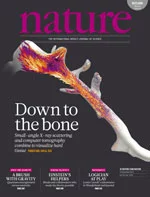The mechanical properties of many materials are based on the macroscopic arrangement and orientation of their nanostructure. This nanostructure can be ordered over a range of length scales. In biology, the principle of hierarchical ordering is often used to maximize functionality, such as strength and robustness of the material, while minimizing weight and energy cost. Methods for nanoscale imaging provide direct visual access to the ultrastructure (nanoscale structure that is too small to be imaged using light microscopy), but the field of view is limited and does not easily allow a full correlative study of changes in the ultrastructure over a macroscopic sample. Other methods of probing ultrastructure ordering, such as small-angle scattering of X-rays or neutrons, can be applied to macroscopic samples; however, these scattering methods remain constrained to two-dimensional specimens or to isotropically oriented ultrastructures. These constraints limit the use of these methods for studying nanostructures with more complex orientation patterns, which are abundant in nature and materials science. Here, we introduce an imaging method that combines small-angle scattering with tensor tomography to probe nanoscale structures in three-dimensional macroscopic samples in a non-destructive way.
- About the CentercloseAbout the Center
- Our Research
- Our User Facilities
- SINQ: Swiss Spallation Neutron Source
- SμS: Swiss Muon Source
- CHRISP: Swiss Research Infrastructure for Particle Physics
- Scientific Advisory Committees
- Publications
- Jobs & Education


